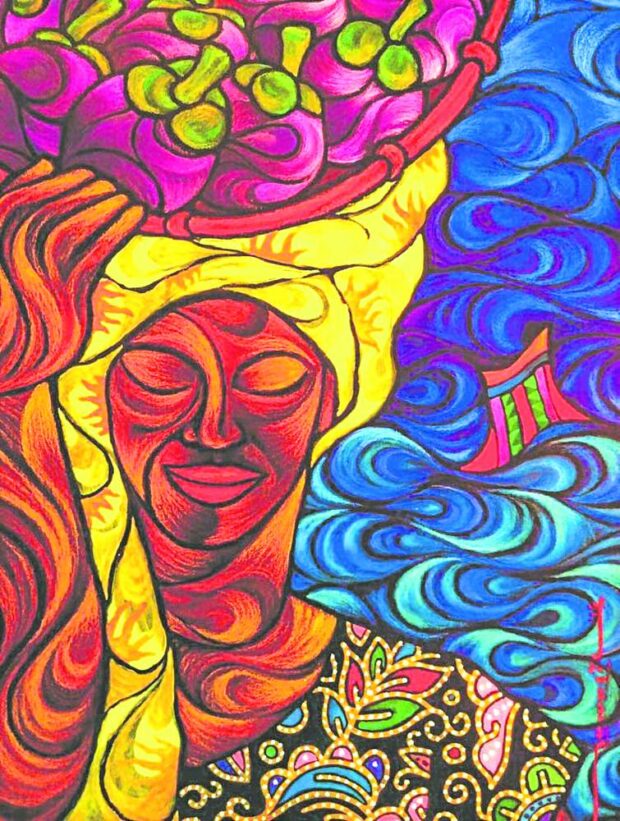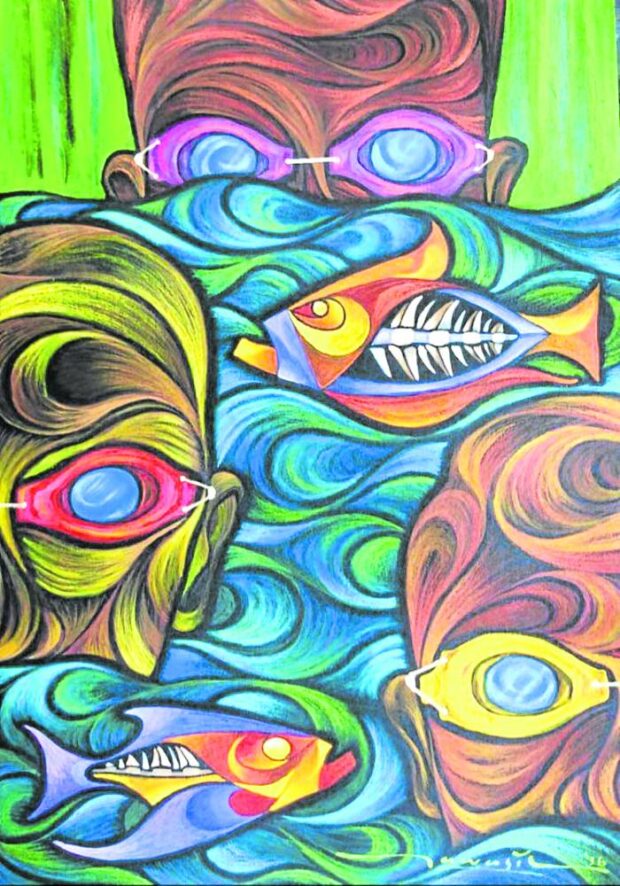‘Ukkil’ artist Rameer Tawasil and his canvas of peace
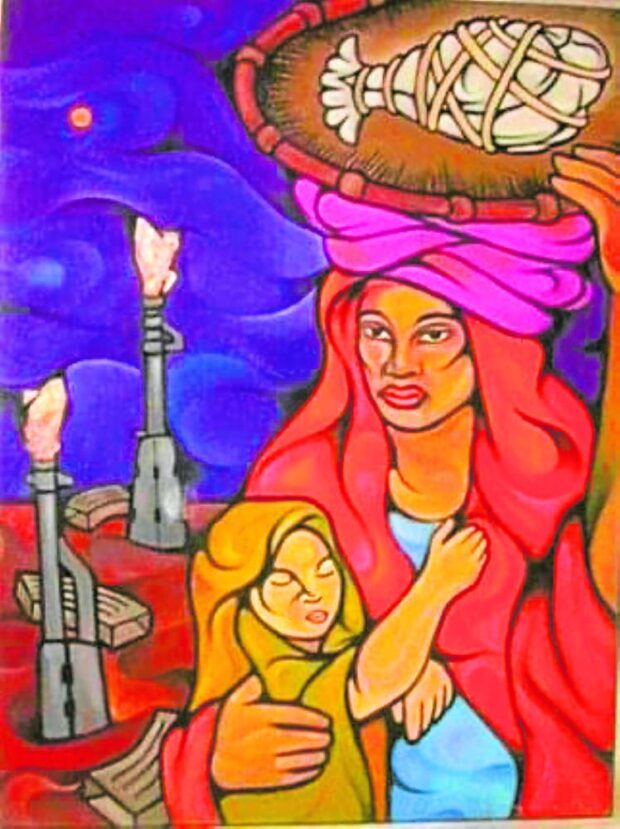
DEPICTING REALITY | The late Tausug “ukkil” artist Rameer Tawasil depicted the social realities in Sulu and Mindanao in his masterpieces, such as the struggle of women to survive and care
for their children amid cycles of conflict that broke out intermittently in his homeland. (Photos courtesy of Amir Mawallil and from the Facebook page of Rameer Tawasil)
ZAMBOANGA CITY, Zamboanga del Sur, Philippines — Tausug “ukkil” artist Rameer Tawasil, who died on June 6, left behind a body of work that greatly contributed to the development of indigenous arts and heritage in the country. Friends and artists he mentored wished he would be honored as such.
Neldy Jolo, Tawasil’s artist friend who teaches history and foreign languages at Mindanao State University, used to fondly call him “Rameeta,” a portmanteau of his full name Rameer Tawasil, but which had a deeper meaning in different languages of the world.
Jolo said the name best described Tawasil’s talent as a visual artist with ukkil strokes, an art form done by the Tausug even before the Spaniards introduced Western painting to the Philippines and Sulu. Ukkil is a curvilinear design form indigenous to Muslim ethnic groups in Mindanao, mainly seen in carvings, brassware, and textiles.
Rameeta in Indian, Jolo said, means “pleasing” and “loved,” reflecting Tawasil being loved by everyone, not just because of his art but also because of his kindness.
In Spanish, Rameeta means twig, spray, sprig, branch, bough, limb, leaf, and line, which suits him as a painter using ukkil as foundation of his art.
Article continues after this advertisementJolo, a Tausug like Tawasil, believed his friend was one of the great ukkilists in modern times. “He is best known for using bright, strong, and bold colors in his paintings,” he said in a post on social media after learning about his friend’s passing. “The basic form and foundation of his art is ukkil, which led him to be tagged as the Tausug ukkilist,” he said.
Jolo recalled the art collaboration they had in 2012 with Julfekar Ahmad Shah, a Malaysia-based Tausug musical artist, in which Tawasil painted the images that accompanied all songs for the album, “Not just Julfekar,” and came up with the exhibit “Julfekar in the Brush of Rameeta” in Kuala Lumpur.
The album was called “Not just Julfekar” because the collection also included song lyrics written by Jolo, while its cover featured paintings rendered by Tawasil.
Fleeing violence
Born in Sulu in 1969, Tawasil was 5 when his family frantically fled the capital town of Jolo in February 1974 amid clashes and bombardments. Witnessing the burning of the then-progressive town left him a deep psychological scar, an experience that would also forge his personal mission of helping build peace and the messages embedded in his art.
Former journalist Darwin Wee, now a government communications executive, recalled Tawasil explaining that he was using his canvas “as a statement against war.”
Wee quoted Tawasil as saying: “I painted them not because I’m a Muslim, not because I am a Mindanaoan or a citizen of this country. I painted them as a citizen of humanity. I hope somewhere between my canvas and emotions, it will touch you.”
Tawasil started painting as early as his elementary years. He was still studying architecture at the Western Mindanao State University when he joined his first group exhibit in 1989 at The Manila Hotel.
In 2003, he held his first solo exhibit entitled “Tawasil” at Garden Orchid Hotel in Zamboanga City. It was also the year that Tawasil garnered the Zamboanga Hermosa Recognition Award for Culture and the Arts and the national traveling exhibition grant from the National Commission for Culture and the Arts (NCCA), Tawasil’s wife Rohanna said.
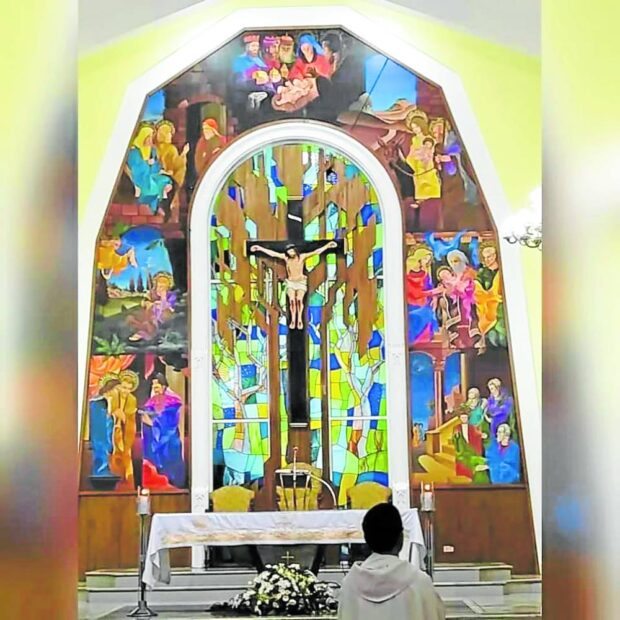
ART BREAKS DIVIDES | Rameer Tawasil, a Muslim, lends his skills to render the altar backdrop of St. Joseph Catholic church in Zamboanga City. (Photo courtesy of DODI FLORETA)
Advocate for peace
In 2006, he received the “Peace Citation Award” from Peace Advocates Zamboanga (Paz) for his rendition of the “peace dove” logo, which later became a peace campaign symbol in the country and abroad, and has been widely used and included in the international symbol of birds.
As an advocate of peace and environmental conservation, he conducted art workshops on recycled and environmental art, organized art shows, and directed musical concerts for peace and environmental conservation.
Paz commissioned Tawasil to do the Peace Monumental Sculpture that was unveiled in Zamboanga City on Nov. 29, 2010. Then presidential peace adviser Teresita Deles said the monument was “a revelation of the Mindanao peoples’ determined refusal to surrender their fate to the forces of conflict and violence.”
Also in November that year, Tawasil joined the European Art Exhibition Tour, “Tanaw Mindanaw,” at BrenART International Art Gallery, the most prestigious and largest one-level art gallery in Brussels, the heart and capital city of the European Union.
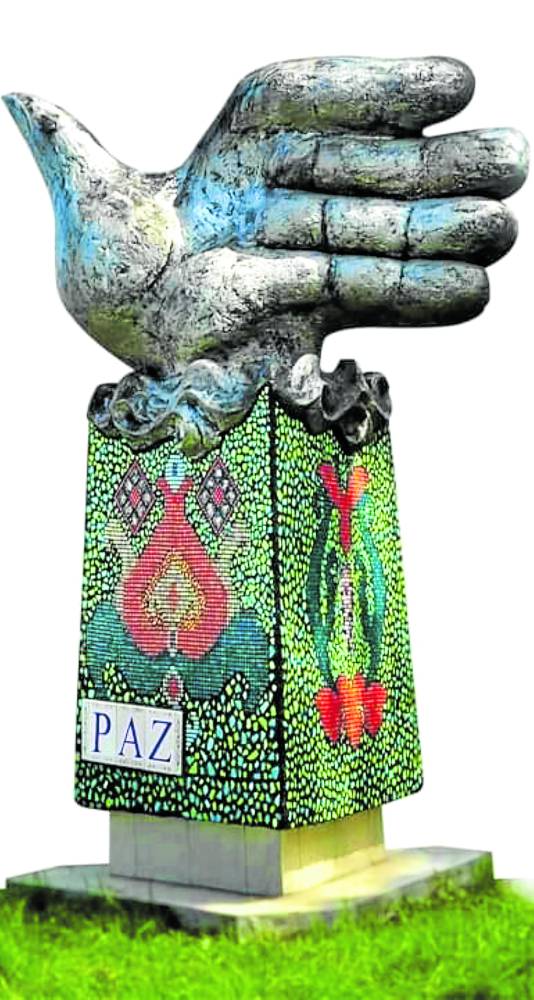
‘SALAM’ | Entitled “Salam,” the Arabic word for peace, this monument by Rameer
Tawasil was unveiled in 2010 on Zamboanga City’s RT Lim Boulevard during the
observance of the annual Mindanao Week of Peace. (Photo from the Facebook page of Rameer Tawasil)
Flying to Belgium was a momentous occasion for him because he was with the first Tausug and Muslim National Artist for Visual Arts, Abdulmari Imao, Jolo recalled. Afterward, both went to Stockholm, Sweden, where the exhibition opened at Agueli Galleri on Nov. 27 that year.
In 2011, Tawasil was one of the six official delegates to Beijing and Shandong, China, to do a mural of the history of Sulu Sultan Paduka Batara who died while on a visit to China in 1417. He contributed to the architectural facade of the P7-billion renovation and development of Paduka Batara’s Shrine.
In 2018, Tawasil helped the children of war-torn Marawi City cope with their trauma by leading a healing and therapy workshop through art.
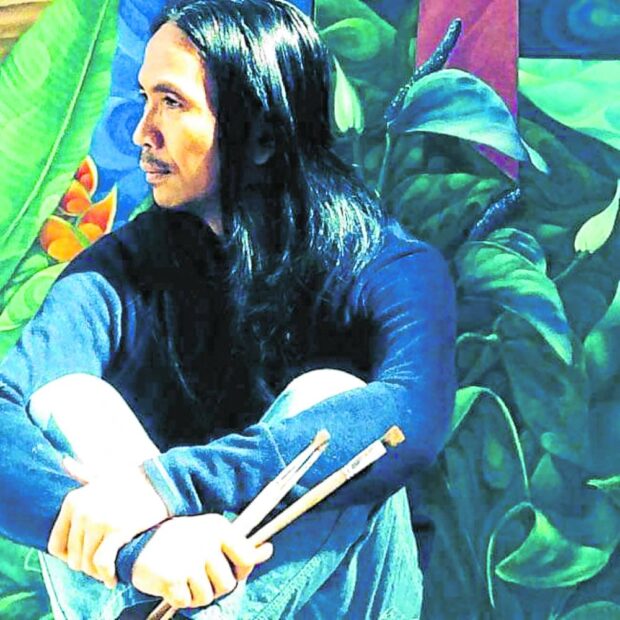
NO TO WAR | Through his mastery of “ukkil,” Rameer Tawasil used his brushes and canvas to convey a statement against war. (Photo from the Facebook page of Rameer Tawasil)
Storyteller
Tawasil’s works had also been featured in various national and international publications, among them, “Space and Identity,” a book published by the Asian Center of the University of the Philippines in Diliman, Quezon City; publications of the NCCA; and in the book, “Voices of Islam in Southeast Asian Studies,” published in Singapore. Many of his works were used as covers for books on Sulu culture, Jolo wrote.
Bangsamoro parliament member Amir Mawallil, a fellow Tausug, remembers Tawasil’s telling of the story of Sulu, his homeland, “which never really disappeared from your artistic expression throughout the years.”
“In essence, you are a storyteller but in the medium of the canvas. Rather, you tell stories through colors, whereas writers do so in words,” Mawallil posted on social media as a tribute to Tawasil.
“More than the genius color play of a maestro that you have come to be known across the country, you also carry the undying flame to push forward the agenda of the Sulu archipelago through each stroke, each color, and each motif and figure. Each piece is never without a story,” Mawallil said.
